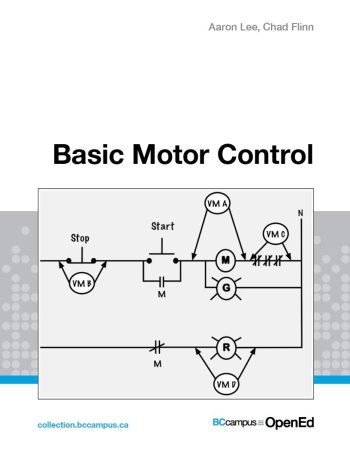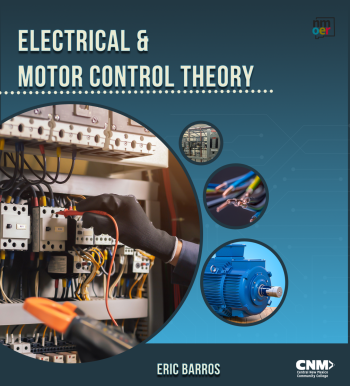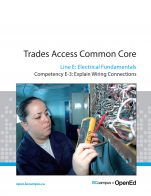
Journals available in EBSCOhost.
Journals available in ProQuest.
Journals available on the web.
 Basic Motor Control
by
Aaron Lee and Chad Flinn
This readily accessible online resource was developed for anyone who has interest in, or works with, AC motors and their associated motor control equipment. Whether you are an electrical apprentice learning about the subject in school or a seasoned journeyperson installing equipment in the field, you will find it easy to navigate through the descriptive text, original diagrams, and explanatory videos to find the exact information you are looking for.
Basic Motor Control
by
Aaron Lee and Chad Flinn
This readily accessible online resource was developed for anyone who has interest in, or works with, AC motors and their associated motor control equipment. Whether you are an electrical apprentice learning about the subject in school or a seasoned journeyperson installing equipment in the field, you will find it easy to navigate through the descriptive text, original diagrams, and explanatory videos to find the exact information you are looking for.
 Electrical and Motor Control Theory
by
Eric Barros
This open education resource (OER) is intended for beginning electrical students currently working in or preparing to enter the electrical field but will provide a guided walk through of simple to advanced electrical theory for anyone looking to further their knowledge. As a beginning electrician, it is important to garner a solid understanding of electrical theory, but arguably even more important to always consider safety first when working on inherently dangerous electrical systems.
Because electrical hazards typically cannot be seen, it is very important to identify potential hazards before they become life threatening. Electricians must work safely around electricity, but also other hazards that arise in construction.
OSHA identifies three things that can significantly reduce the possibility of personal injury: Safe work habits, PPE, proper procedures.
OSHA (Occupational Safety and Health Administration) mandates that employers shall provide a safe workplace for its employees.
The purpose of the NEC is the practical safeguarding of people and property form the hazards arising from the use of electricity. 90.1
Electrical and Motor Control Theory
by
Eric Barros
This open education resource (OER) is intended for beginning electrical students currently working in or preparing to enter the electrical field but will provide a guided walk through of simple to advanced electrical theory for anyone looking to further their knowledge. As a beginning electrician, it is important to garner a solid understanding of electrical theory, but arguably even more important to always consider safety first when working on inherently dangerous electrical systems.
Because electrical hazards typically cannot be seen, it is very important to identify potential hazards before they become life threatening. Electricians must work safely around electricity, but also other hazards that arise in construction.
OSHA identifies three things that can significantly reduce the possibility of personal injury: Safe work habits, PPE, proper procedures.
OSHA (Occupational Safety and Health Administration) mandates that employers shall provide a safe workplace for its employees.
The purpose of the NEC is the practical safeguarding of people and property form the hazards arising from the use of electricity. 90.1
 Encyclopedia of Computer Science and Technology
by
Henderson, Harry
This eBook provides an extensive summary of how technology has developed over decades, the future of computer programs and applications, and the significance of computer components.
Encyclopedia of Computer Science and Technology
by
Henderson, Harry
This eBook provides an extensive summary of how technology has developed over decades, the future of computer programs and applications, and the significance of computer components.
 Fundamentals of Electricity
by
Vrettos, Andreas
Objectives: After completion of this Unit, the student should be able to:
Understand the structure of this book, in Parts, Units, and Topics
Explain Static Electricity
Understand the structure of the atom
Understand the difference between Conductors and Insulators
Book structure
This is a book on basic electricity and electronics. It consists of the following parts:
Part I: Direct Current (DC) circuit analysis. This part treats 11DC topics (1 to 11) split among 7 Units.
Part II: Alternating Current (AC) circuit analysis. This part treats 5 AC topics ( 1 to 5) split among Units 8.9 and 10.
Part III: Introduction to Solid-State devices and circuits This part treats 4 SS topics (1 to 4) split in 4 Units.
Fundamentals of Electricity
by
Vrettos, Andreas
Objectives: After completion of this Unit, the student should be able to:
Understand the structure of this book, in Parts, Units, and Topics
Explain Static Electricity
Understand the structure of the atom
Understand the difference between Conductors and Insulators
Book structure
This is a book on basic electricity and electronics. It consists of the following parts:
Part I: Direct Current (DC) circuit analysis. This part treats 11DC topics (1 to 11) split among 7 Units.
Part II: Alternating Current (AC) circuit analysis. This part treats 5 AC topics ( 1 to 5) split among Units 8.9 and 10.
Part III: Introduction to Solid-State devices and circuits This part treats 4 SS topics (1 to 4) split in 4 Units.
 Industrial Automation Sensors and Motors
by
Neha Kardam
The pace of technological advancement is constantly accelerating, and automation is rapidly transforming how businesses operate and industries function. Lake Washington Institute of Technology (LWTech), a leading provider of innovative technology education, is at the forefront of this exciting shift. Through our commitment to career-focused education, LWTech offers the “Industrial Automation Sensors And Motors” course. This course equips students with the knowledge and skills necessary to thrive in the automated workplace of tomorrow.
Industrial Automation Sensors and Motors
by
Neha Kardam
The pace of technological advancement is constantly accelerating, and automation is rapidly transforming how businesses operate and industries function. Lake Washington Institute of Technology (LWTech), a leading provider of innovative technology education, is at the forefront of this exciting shift. Through our commitment to career-focused education, LWTech offers the “Industrial Automation Sensors And Motors” course. This course equips students with the knowledge and skills necessary to thrive in the automated workplace of tomorrow.
 Line E: Electrical Fundamentals Competency E-3: Explain Wiring Connections
by
Camosun College
"It is important for you to be familiar with techniques for soldering electrical connections and how to use wireless connectors. For example, the ends of the finely stranded wires used for power supply cords on most portable power tools are soldered to permit a long-lasting, troublefree connection. Solder also produces secure, durable electrical connections for switches, plugs, and tools. Wireless connectors are commonly used in many electrical applications because they are quick and easy to use.The following list of lines and competencies was generated with the goal of creating an entry-level trades training resource, while still offering the flexibility for lines to be used as stand-alone books. E-1 Describe the Basic Principles of Electricity, E-2 Identify Common Circuit Components and Their Symbols, E-3 Explain Wiring Connections, E-4 Use Multimeters. Special thanks to CAPER-BC (https://caperbc.ca/) for creating the audio recording for each Competency." - works with ELT 221
Line E: Electrical Fundamentals Competency E-3: Explain Wiring Connections
by
Camosun College
"It is important for you to be familiar with techniques for soldering electrical connections and how to use wireless connectors. For example, the ends of the finely stranded wires used for power supply cords on most portable power tools are soldered to permit a long-lasting, troublefree connection. Solder also produces secure, durable electrical connections for switches, plugs, and tools. Wireless connectors are commonly used in many electrical applications because they are quick and easy to use.The following list of lines and competencies was generated with the goal of creating an entry-level trades training resource, while still offering the flexibility for lines to be used as stand-alone books. E-1 Describe the Basic Principles of Electricity, E-2 Identify Common Circuit Components and Their Symbols, E-3 Explain Wiring Connections, E-4 Use Multimeters. Special thanks to CAPER-BC (https://caperbc.ca/) for creating the audio recording for each Competency." - works with ELT 221
Here are web forums where you can "chat" with other machinists on topics of current interest and do a little networking.
Career Resources
The following are some of the many professional associations for those employed in ELT fields.
Central Maine Community College Learning Commons - 1250 Turner St., Auburn, Maine 04210 - Telephone: (207)755-5218
Central Maine Community College is an equal opportunity/affirmative action institution and employer.
For more information, please call (207) 755-5100. [Full Non-Discrimination Notice]